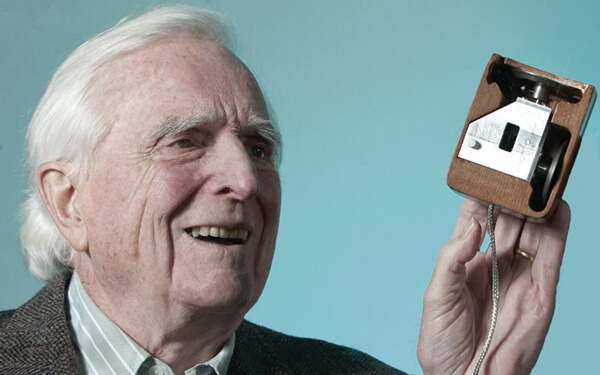He is best remembered for the invention of the mouse: Who is Douglas Engelbart?
He is one of those who came up with the ideas of "e-mail" and "teleconference", which are indispensable today, at the California Research Institute. It is surprising that he was an electrical engineer who only knew computers from what he read in books when he was growing up.

The Turing Award winner, who made a great contribution to the development of computer interfaces, is a scientist far ahead of his time.
Engelbart envisioned a world in which people used computers for purposes such as sharing their thoughts and searching for solutions to their problems, and he thought focused on information sharing. His development of the "Online System" (NLS), which was of great importance as it allowed researchers to create and share documents on an electronic library and became an application for the ARPANet computer network, is a concrete example of what he thought.
Douglas Carl Engelbart (January 30, 1925 – July 2, 2013) was an American engineer and inventor, and an early computer and Internet pioneer. He is best known for his work on founding the field of human–computer interaction, particularly while at his Augmentation Research Center Lab in SRI International, which resulted in creation of the computer mouse, and the development of hypertext, networked computers, and precursors to graphical user interfaces. These were demonstrated at The Mother of All Demos in 1968. Engelbart's law, the observation that the intrinsic rate of human performance is exponential, is named after him.
Douglas Carl Engelbart was born on January 30, 1925, in Portland, Oregon, and grew up on a small farm. After graduating from high school in 1942, he began studying electrical engineering at Oregon State University; However, his education was interrupted by the outbreak of World War II, and Engelbart joined the US Navy that year and spent 2 years as a radar technician in the Philippines.
While in the Philippines, Engelbart read Vannevar Bush's article "As We May Think" in the Atlantic Monthly magazine, which included a call to make science more accessible, and was greatly influenced by it, After the war, he focused on computer science.
Returning to university after the war, Engelbart graduated from Oregon State University in electrical engineering in 1948 and began working at NACA, the predecessor of NASA. Engelbart, who was fascinated by ideas focused on information sharing in the 1950s and was still under the influence of Vannevar Bush's article, completed his doctorate in electrical engineering at UC Berkeley in 1955 in line with his goals and remained there as an assistant professor.
Engelbart, who soon left his assistant professorship in pursuit of his dreams of turning the computer into a tool that would support human intelligence and popularizing its use, joined the Stanford Research Institute (RSI) in 1957. Here, Engelbart founded the Augmented Research Center, funded by the Air Force and the Pentagon's special R&D unit, the Defense Advanced Research Projects Agency (DARPA), and in 1962 he published a project called Augmenting Human Intellect: A Conceptual Framework, aimed at explaining augmented human mental abilities. wrote the research report.
The laboratory founded by Engelbart, who created the first teleconference in history by connecting to a computer conference held in San Francisco in 1969 from his home with a modem he developed and astonished the audience, became the home of ARPANET, one of the studies that laid the foundations of the Internet in 1970.
After establishing his own laboratory, Engelbart conducted research on the mouse with the Xerox Star brand computer and prepared his first prototype in 1965. Thanks to the two wheels of the first mouse, which were quite large, standing perpendicular to each other, movements made in both horizontal and vertical axes could be transferred to the computer. This model had a single button for marking and was designed in the form of a wooden shell that did not fit well in the hand and had nothing to do with ergonomics.
Later, Bill English, another engineer who shared the same laboratory with Engelbart, improved Engelbart's design by using a ball inside the mouse body that contacted the shafts, instead of the large wheels in this first mouse. The ball again contacted two shafts perpendicular to each other, thus movement information was transferred to the system. Developer Douglas Engelbart, who introduced his product on December 9, 1968, patented the mouse under the name "X-Y guide system for imaging systems" in 1970.
Douglas Engelbart patented 21 inventions during his career. He was deemed worthy of many awards for his research and work throughout his life.
This genius scientist, who is known to have trained people who later became involved in many companies in Silicon Valley, who can be called a pioneer with his thoughts and deeds, and who is considered one of the most important engineers of the computer age, died in California on July 2, 2013, at the age of 88, due to kidney failure.
